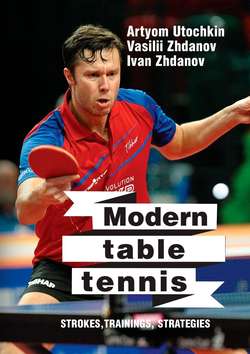Читать книгу Modern table tennis: strokes, trainings, strategies - Artyom Utochkin - Страница 16
Different variations of the forehand top-spin
Variation #7. Forehand top-spin on the uprated ball
ОглавлениеIn the game, there are often balls that are very easy for winning points.
For example, you made a short serve with a side top-spin, your opponent didn’t notice that, he performed a chop and the ball turned out very high, you might even say, perfect to complete the attack.
However, oddly enough, many athletes make a lot of mistakes when playing such balls. Let’s try to understand why.
We often train classic top-spin against the block, but rarely the chopped top-spin. Generally, the least attention is given to the rest of the forehand top-spin variations in the training process. What is the result?
As a result, the hand is accustomed to some extent to always direct the ball with more flat trajectory. That is, to direct the move up more than forward. And it is correct for the two abovementioned variations.
But at a top-spin on the uprated ball, it is necessary to direct move a lot more ahead. Not forgetting to add a spin to it.
Many tennis players who perform top-spin on the uprated ball stumble over these 2 things. Either one plays ball too high and it flies beyond the table, or tries to play it too hard (without spin) and the ball flies into the net.
One of the key reasons due to which there are a lot of mistakes made with such balls, many mistakes, is the psychological aspect.
When such ball appears in front of the athlete, it usually happens unexpectedly and unplanned. Following idea immediately strikes in such situation: “Now.. I have to score..”. But no, this attitude is not conducive to win a point.
Let’s take a look at actions in this situation by the example of the world strongest athletes.
Firstly, such balls can’t be “unplanned” for them. If they make a short serve with side topspin or flat serve, they initially assume that one of the options to continue this rally would be a high ball. Yes it will happen rarely, but deep in their consciousness they support this moment.
Secondly, if this ball appeared unexpectedly for them, then they would not try to win points immediately. They would prefer to perform more stable top-spin. Right, maybe the point won’t be won due to this action, but there would be no mistake, and the initiative would be possessed, which is a pretty good situation.
Another point, which is not refined by many tennis players is marching on towards such ball. Here’s the psychology again. Crazy idea about a fast winning of points emerges and the athlete tries to win the point immediately, without taking a comfortable position to perform a complete top-spin. Moreover, such situations arise at competitions constantly. And the interesting thing is that we are in no hurry to do a classic top-spin, not marching on to him, because we understand that a simple top-spin does not warrant us winning points. Therefore, we are not in a hurry. But as soon as we see a high ball here – we forget about what we need to march on because nothing would work out. Pure psychology.
Now let’s talk about technique in such balls.
As you have already understood from the preceding paragraph, march on is crucially important for successful implementation of high ball top-spin. Everything here is not as easy as it might seem at first glance.
The fact of the matter is that the high ball top-spin on can be divided into two versions: high ball top-spin from the right corner and the same top-spin from the left corner.
Do you remember that we faced the same gradation when we were learning forehand top-spin on a half-long ball. And for good reason.
The uprated ball is usually not too long. And that’s why the same division as in case of the outflying ball is relevant here. That is why we are studying this variation after forehand top-spin on the half-long ball (Artem Utochkin in his coaching practice calls such element as top-spin on the uprated half-long ball).
Let’s start with top-spin on the uprated ball on the move because uprated ball drops to a left side of the table in 60—70% of cases.
The critical moment for such top-spin performance, especially if you want to make it to win points, is a point of the ball flight, where you would play it.
The point must be higher after ball bounce off the table. If you start doing too early, the probability of error is maximum. Just try to play such ball on a training, not waiting for the highest point of rebound, and you’ll see it on your own.
If you start to do it in a moment when the ball begins to drop, then the error probability also increases significantly. With each lost centimeter a chance to perform a powerful top-spin drops because the ball is not high enough to fulfill top-spin to win points.
Remember: If you missed the moment of the highest point, then forget about top-spin to win. Make a simple top-spin, as if played with chopped or outflying ball. Yes, perhaps you would not win a point immediately, but you would take the initiative into your own hands, is this bad?
As you may recall the explanation concerning playing half-long balls with a marching on, we don’t need to change the feet position here, since nothing prevents left foot to stand on the side line.
When executing top-spin, it is recommended to make a slight movement: left foot semi-step forward. This allows you to have more control over the ball and greatly increases the power of your top-spin.
